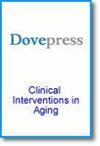Predictive Value of Lysophosphatidylcholine for Determining the Disease Severity and Prognosis of Elderly Patients with Community-Acquired Pneumonia
IF 3.7
3区 医学
引用次数: 0
Abstract
Purpose: To investigate the clinical value of serum lysophosphatidylcholine (LPC) as a predictive biomarker for determining disease severity and mortality risk in hospitalized elderly patients with community-acquired pneumonia (CAP).Methods: This prospective, single-center study enrolled 208 elderly patients, including 67 patients with severe CAP (SCAP) and 141 with non-SCAP between November 1st, 2020, and November 30th, 2021 at the Qingdao Municipal Hospital, Shandong Province, China. The demographic and clinical parameters were recorded for all the included patients. Serum LPC levels were measured on day 1 and 6 after admission using ELISA. Propensity score matching (PSM) was used to balance the baseline variables between SCAP and non-SCAP patient groups. Receiver operative characteristic (ROC) curve analysis was used to compare the predictive performances of LPC and other clinical parameters in discriminating between SCAP and non-SCAP patients and determining the 30-day mortality risk of the hospitalized CAP patients. Univariate and multivariate logistic regression analyses were performed to identify the independent risk factors associated with SCAP. Cox proportional hazard regression analysis was used to determine if serum LPC was an independent risk factor for the 30-day mortality of CAP patients.
Results: The serum LPC levels at admission were significantly higher in the non-SCAP patients than in the SCAP patients (P = 0.011). Serum LPC level < 24.36 ng/mL, and PSI score were independent risk factors for the 30-day mortality in the elderly patients with CAP. The risk of 30-day mortality in the elderly CAP patients with low serum LPC levels (< 24.36ng/mL) was > 5-fold higher than in the patients with high serum LPC levels (≥ 24.36ng/mL).
Conclusion: Low serum LPC levels were associated with significantly higher disease severity and 30-day mortality in the elderly patients with CAP. Therefore, serum LPC is a promising predictive biomarker for the early identification of elderly CAP patients with poor prognosis.
Keywords: lysophosphatidylcholine, community-acquired pneumonia, biomarker, severity, mortality, propensity score matching
溶血磷脂酰胆碱对确定社区获得性肺炎老年患者病情严重程度和预后的预测价值
目的:探讨血清溶血磷脂酰胆碱(LPC)作为一种预测性生物标志物在确定住院老年社区获得性肺炎(CAP)患者疾病严重程度和死亡风险方面的临床价值:这项前瞻性单中心研究在2020年11月1日至2021年11月30日期间,在中国山东省青岛市立医院招募了208名老年患者,其中包括67名重症CAP(SCAP)患者和141名非SCAP患者。所有纳入患者的人口统计学和临床参数均已记录。入院后第1天和第6天使用ELISA法测定血清LPC水平。采用倾向得分匹配法(PSM)平衡 SCAP 和非 SCAP 患者组之间的基线变量。采用接收操作特征(ROC)曲线分析比较 LPC 和其他临床参数在区分 SCAP 和非 SCAP 患者以及确定住院 CAP 患者 30 天死亡风险方面的预测性能。为确定与 SCAP 相关的独立风险因素,进行了单变量和多变量逻辑回归分析。采用 Cox 比例危险回归分析确定血清 LPC 是否是 CAP 患者 30 天死亡率的独立危险因素:结果:非 SCAP 患者入院时的血清 LPC 水平明显高于 SCAP 患者(P = 0.011)。血清 LPC 水平 24.36 纳克/毫升和 PSI 评分是老年 CAP 患者 30 天死亡率的独立危险因素。血清LPC水平低(< 24.36ng/mL)的老年CAP患者30天死亡风险是血清LPC水平高(≥ 24.36ng/mL)患者的> 5倍:结论:在老年 CAP 患者中,低血清 LPC 水平与较高的疾病严重程度和 30 天死亡率明显相关。因此,血清 LPC 是一种很有前景的预测性生物标志物,可用于早期识别预后不良的老年 CAP 患者。 关键词:溶血磷脂酰胆碱;社区获得性肺炎;生物标志物;严重程度;死亡率;倾向评分匹配
本文章由计算机程序翻译,如有差异,请以英文原文为准。
求助全文
约1分钟内获得全文
求助全文
来源期刊

Clinical Interventions in Aging
GERIATRICS & GERONTOLOGY-
CiteScore
6.20
自引率
2.80%
发文量
193
期刊介绍:
Clinical Interventions in Aging, is an online, peer reviewed, open access journal focusing on concise rapid reporting of original research and reviews in aging. Special attention will be given to papers reporting on actual or potential clinical applications leading to improved prevention or treatment of disease or a greater understanding of pathological processes that result from maladaptive changes in the body associated with aging. This journal is directed at a wide array of scientists, engineers, pharmacists, pharmacologists and clinical specialists wishing to maintain an up to date knowledge of this exciting and emerging field.
 求助内容:
求助内容: 应助结果提醒方式:
应助结果提醒方式:


